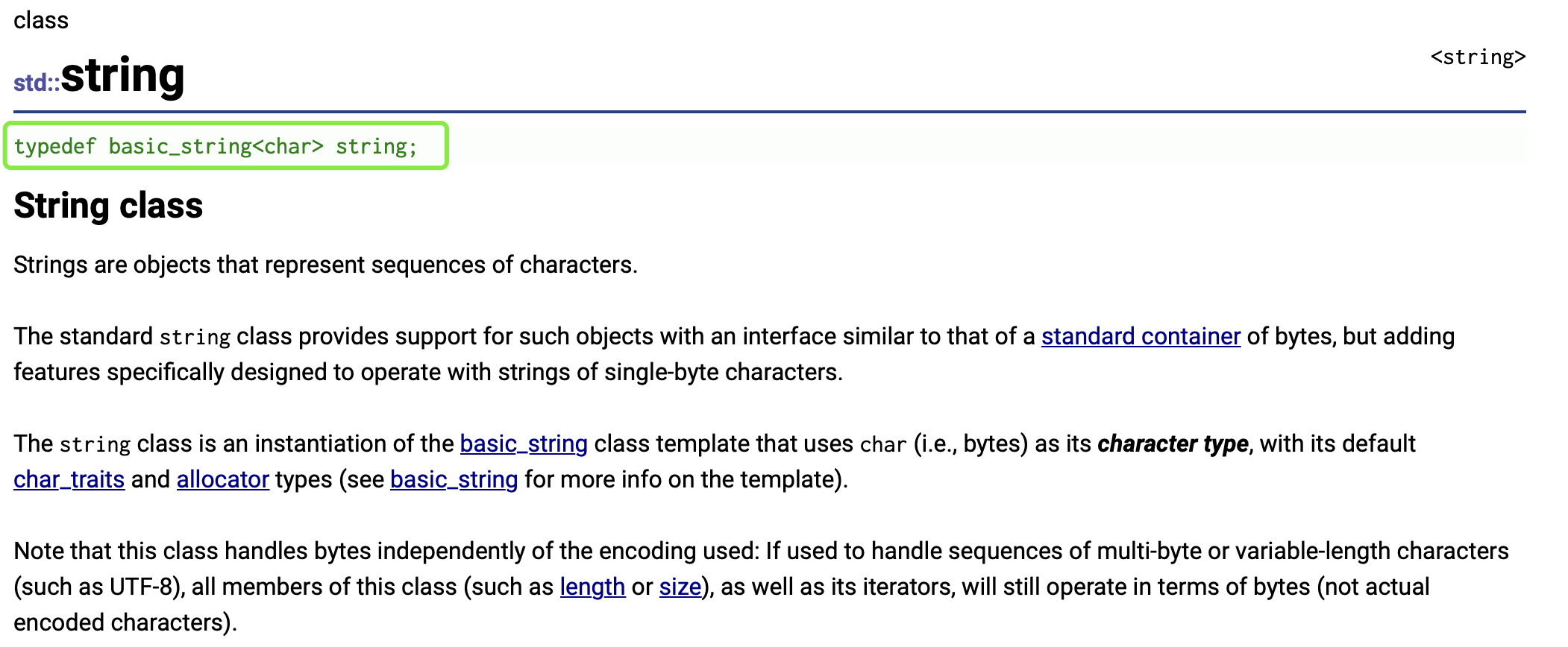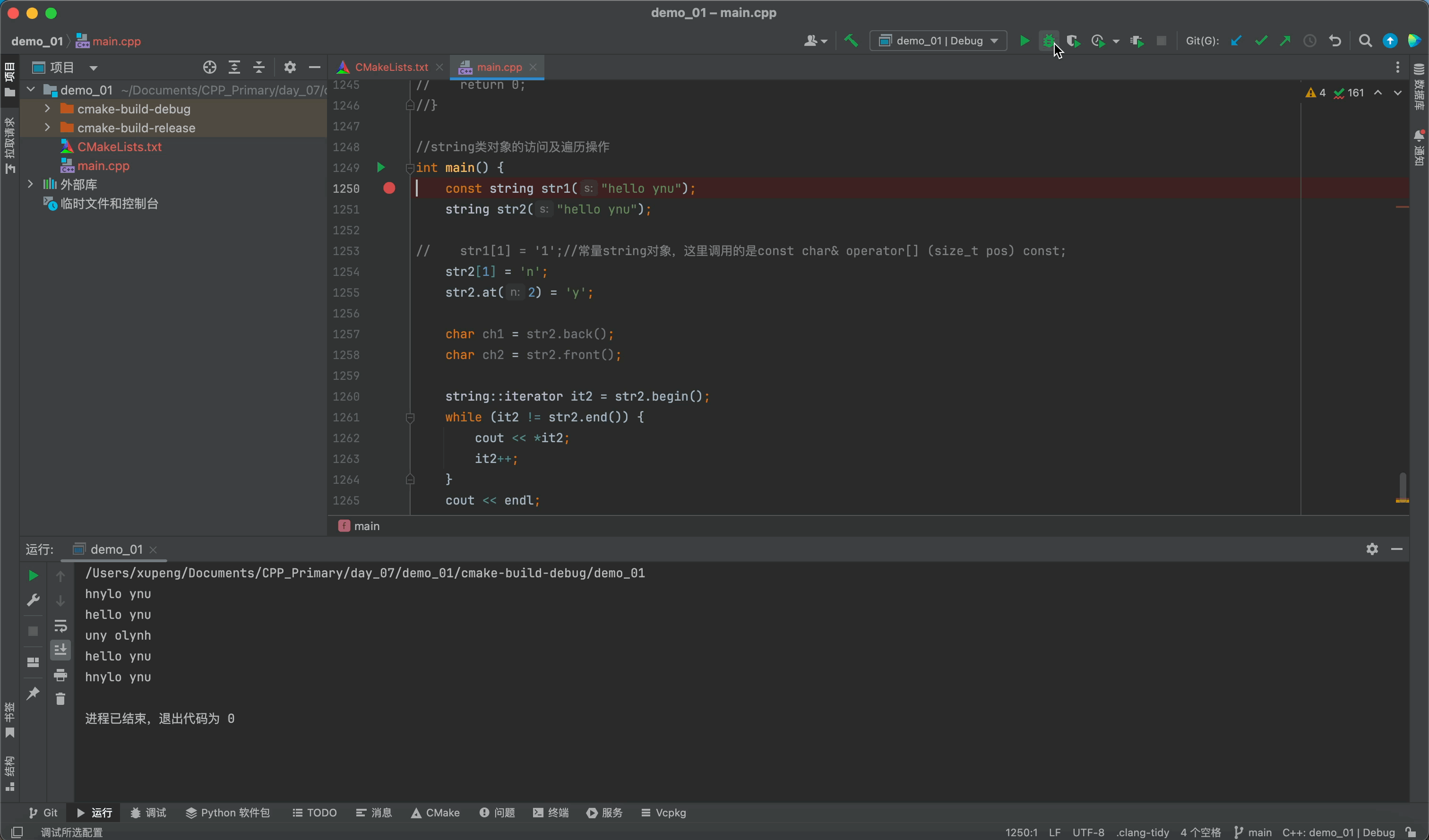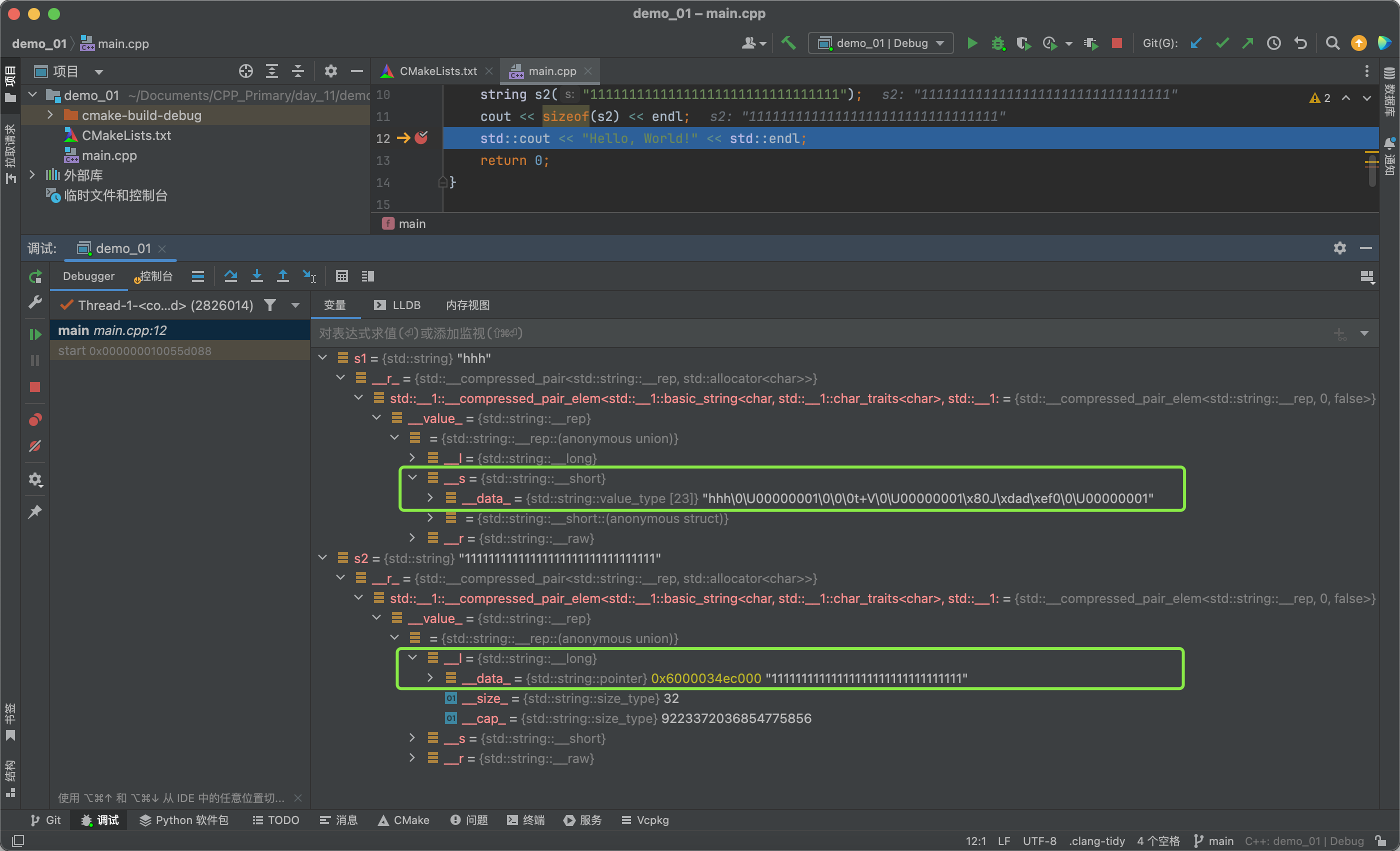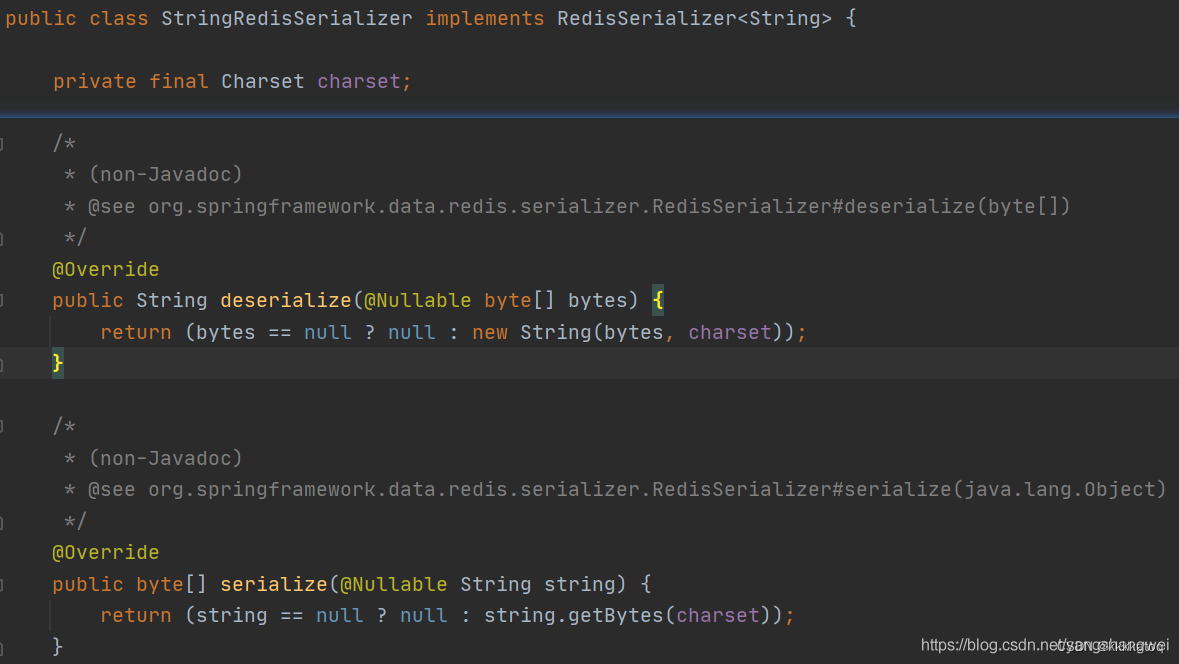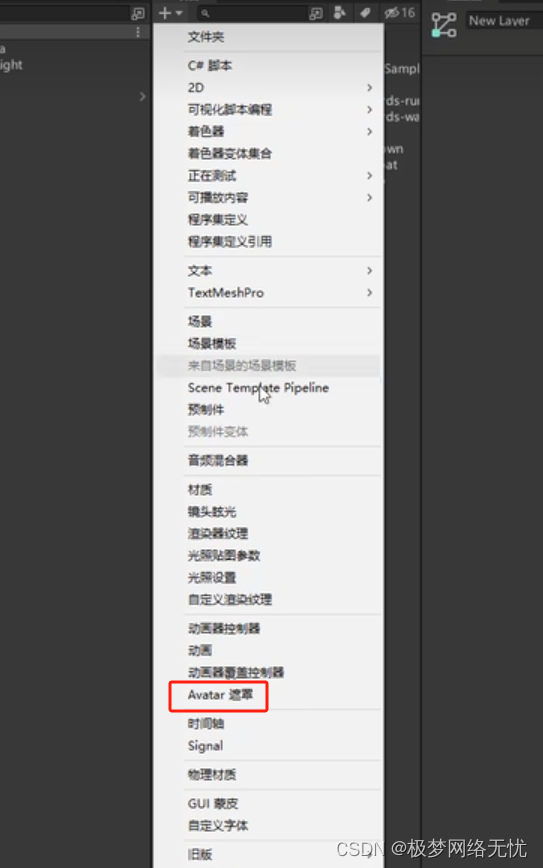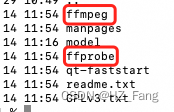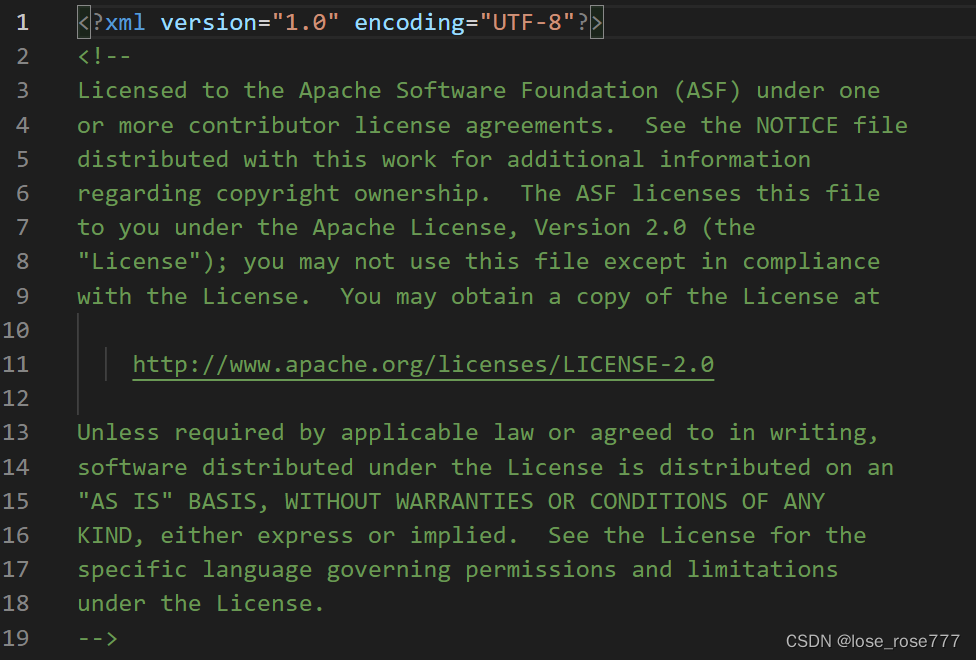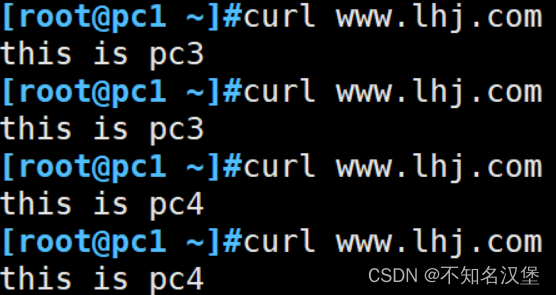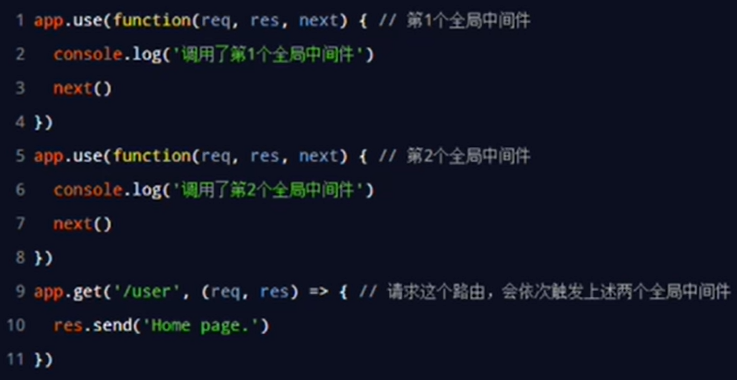文章目录
- STL容器之string类
- 1、 什么是STL
- 2、STL的六大组件
- 3、string类
- 3.1、string类介绍
- 3.2、string类的常用接口说明
- 3.2.1、string类对象的常见构造
- 3.2.2、string类对象的容量操作
- 3.2.3、string类对象的访问及遍历操作
- 3.2.4、 string类对象的修改操作
- 3.2.5、 string类非成员函数
- 3.3、 vs和g++下string结构的说明
- 4、string类的模拟实现

STL容器之string类
1、 什么是STL
C++标准模板库(Standard Template Library,STL)是C++标准库的一部分,提供了一组通用的模板类和函数,以实现常见的数据结构和算法。
2、STL的六大组件
STL包含了多个模块,其中一些主要的包括:
容器(Containers):
string:它被设计为一个动态数组,提供了一系列成员函数来操作字符串,同时自动处理内存的分配和释放。
vector: 动态数组,可动态调整大小。
list: 双向链表。
deque: 双端队列,支持在两端高效地插入和删除元素。
queue: 队列。
stack: 栈。
set: 集合,不允许重复元素。
map: 映射,键-值对的关联容器。
unordered_set 和 unordered_map: 使用哈希表实现的集合和映射。
算法(Algorithms):
- 提供了许多常见的算法,如排序、搜索、遍历等。
- 包括了泛型算法,例如
sort、find、binary_search等。
迭代器(Iterators):
- 提供了多种迭代器类型,用于遍历不同类型的数据结构。
函数对象(Function Objects)也称仿函数(functor):
- 包括了一些预定义的函数对象,如比较器等。
适配器(Adapters):
- 提供了用于修改容器接口的适配器,如
stack、queue和priority_queue(优先队列,基于堆实现)。空间配置器(allocator):
- std::allocator: 是STL中默认的空间配置器。它使用
new和delete运算符来进行内存分配和释放。
3、string类
3.1、string类介绍
string类的文档介绍
- 字符串是表示字符序列的类
- 标准的字符串类提供了对此类对象的支持,其接口类似于标准字符容器的接口,但添加了专门用于操作单字节字符/字符串的设计特性。
- string类是使用char(即作为它的字符类型,使用它的默认char_traits和分配器类型(关于模板的更多信息,请参阅basic_string)。
- string类是basic_string模板类的一个实例,它使用char来实例化basic_string模板类,并用char_traits和allocator作为basic_string的默认参数(根于更多的模板信息请参考basic_string)。
- 注意:这个类独立于所使用的编码来处理字节:如果用来处理多字节或变长字符(如UTF-8)的序列,这个类的所有成员(如长度或大小)以及它的迭代器,将仍然按照字节(而不是实际编码的字符)来操作。
总结:
- string是表示字符串的字符串类。
- 该类的接口与常规容器的接口基本相同,再添加了一些专门用来操作string的常规操作。
- string在底层实际是:basic_string模板类的别名,typedef basic_string<char, char_traits, allocator> string。
- 不能操作多字节或者变长字符的序列。
注意:在使用string类时,必须包含#include头文件(
#include <string>)以及using namespace std;。
3.2、string类的常用接口说明
string类对象其实就是字符串,但是字符串不一定是string类对象。
3.2.1、string类对象的常见构造
(constructor)函数名称 功能说明 string()(重点) 构造空的string类对象,即空字符串 string (const string& str)(重点) 拷贝构造函数 string (const string& str, size_t pos, size_t len = npos) 构造从string类对象str的pos位置向后len长度的string类对象 string (const char s)(重点)* 用C-string(字符串,不是字符串对象)来构造string类对象 string (const char s, size_t n)* 构造字符串s从开始位置到n位置的string类对象 string (size_t n, char c) 构造n个连续字符c的string类对象 int main() { //构造函数/拷贝构造函数 string s1; cout << s1 << endl; string s2("hello"); cout << s2 << endl; string s3(s2); cout << s3 << endl; string s4(s3, 2, 10); cout << s4 << endl; string s5("world", 2); cout << s5 << endl; return 0; }
3.2.2、string类对象的容量操作
函数名称 功能说明 size(重点) 返回string类对象有效字符长度 length 返回string类对象有效字符长度 max_size 返回string类对象可以达到的最大字符长度 resize(重点) 将有效字符的个数改成n个,多出的空间用字符c填充(如果有参数字符c) capacity 返回当前已经分配给string类对象的存储空间大小,单位是字节 reserve(重点) 要求string类对象的容量调整为计划好的容量(参数为n),如果n小于之前的容量,则不调整,大于则调整为n(看编译器,有些编译器可能大于n) clear(重点) 清空string类对象的内容,使其变成一个空字符串 empty(重点) 判断string类对象是不是空 int main() { string s1("hello world a"); cout << s1.capacity() << endl;//返回当前已经分配给字符串的存储空间大小,单位是字节 cout << s1.size() << endl;//返回字符串有效字符长度 cout << s1.length() << endl;//返回字符串有效字符长度 cout << s1.max_size() << endl;//返回字符串可以达到的最大字符长度 s1.resize(25, 'x');//将有效字符的个数该成n个,多出的空间用字符c填充(如果有参数字符c) cout << s1.size() << endl; cout << s1.capacity() << endl; s1.reserve(33);//要求字符串的容量调整为计划好的容量(参数为n),如果n小于之前的容量,则不调整,大于则调整为n(看编译器,有些编译器可能大于n) cout << s1 << endl; cout << s1.capacity() << endl; s1.clear();//清空字符串的内容,使其变成一个空字符串 cout << s1.empty() << endl;//判断字符串是不是空 return 0; }注意:
- size()与length()方法底层实现原理完全相同,引入size()的原因是为了与其他容器的接口保持一致,一般情况下基本都是用size()。
- clear()只是将string中有效字符清空,不改变底层空间大小。
- resize(size_t n) 与 resize(size_t n, char c)都是将字符串中有效字符个数改变到n个,不同的是当字符个数增多时:resize(n)用0来填充多出的元素空间,resize(size_t n, char c)用字符c来填充多出的元素空间。注意:resize在改变元素个数时,如果是将元素个数增多,可能会改变底层容量的大小,如果是将元素个数减少,底层空间总大小不变。既影响容量,也影响数据。
- reserve(size_t res_arg=0):为string预留空间,不改变有效元素个数,当reserve的参数小于string的底层空间总大小时,reserver不会改变容量大小。只影响容量,不影响数据。
3.2.3、string类对象的访问及遍历操作
函数名称 功能说明 operator[](重点) 返回string类对象在pos位置的字符引用,分const和非const,const则字符串内容(字符)不能被修改 at 和opreator功能一样 back 取string类对象象的末尾字符 front 取string类对象的最前面字符 begin 返回一个迭代器指向string类对象最前面的字符,分const和非const,const是使得this指向的内容不能改变 end 返回一个迭代器指向string类对象最后面的字符的后面一个位置,和begin一样,分const和非const rbegin 反向迭代器,和begin差不多,就是这是指向string类对象最末尾字符位置 rend 反向迭代器,和begin差不多,就是这是指向string类对象最前面字符的前一个位置 cbegin 和begin差不多,但是这是专门用于const迭代器的 crbegin 和cbegin差不多,就是这是指向string类对象最末尾字符位置 范围for C++11支持更简洁的范围for的新遍历方式 int main() { const string str1("hello ynu"); string str2("hello ynu"); // str1[1] = '1';//常量string对象,这里调用的是const char& operator[] (size_t pos) const; str2[1] = 'n'; str2.at(2) = 'y'; char ch1 = str2.back(); char ch2 = str2.front(); string::iterator it2 = str2.begin(); while (it2 != str2.end()) { cout << *it2; fflush(stdout);//将缓冲区数据刷新到终端 it2++; } cout << endl; //const迭代器 string::const_iterator it1 = str1.begin(); while (it1 != str1.end()) { cout << *it1; it1++; } cout << endl; //反向迭代器 string::reverse_iterator it3 = str2.rbegin(); while (it3 != str2.rend()) { cout << *it3; it3++; } cout << endl; //专属/const迭代器 string::const_iterator it = str1.cbegin(); while (it != str1.end()) { cout << *it; it++; } cout << endl; //范围for for (auto e: str2) { cout << e; } cout << endl; return 0; }
3.2.4、 string类对象的修改操作
函数名称 功能说明 operator+=(重点) 在string类对象末尾追加字符、字符串或者string类对象 append 在string类对象末尾追加字符(参数需要加上添加字符的个数n)、字符串或者string类对象 push_back 在string类对象末尾增加一个字符 npos(重点) 大小为无符号数的最大值,用int表示即-1 insert 在string类对象pos位置之前插入字符(参数需要加上添加字符的个数n)、字符串或者string类对象 erase 从string类对象pos位置开始删除长度为len的字符串,若不指定len,则len为npos(最大无符号int值) replace 从string类对象pos位置开始向后长度为len的字符串替换为新字符(参数需要加上添加字符的个数n)、新字符串或者新string类对象 swap 用一个新string类对象交换本string类对象的内容。注意这里是引用,可以减少对象拷贝 c_str(重点) 返回C格式字符串,这个比data常用 data 和c_str一样 copy 将string类对象从pos位置开始向后的n个字符复制到新字符数组里,并返回这个复制的字符串长度 find string类对象从pos位置开始向后查找字符、字符串或者string类对象,返回第一次出现的起始字符位置。pos不指定,则从string类对象的第一个字符开始查找。没找到则返回npos rfind 和find差不多,这是pos位置从后往前找,找到返回返回第一次出现的起始字符位置。没找到返回npos find_first_of 在string类对象中找到字符、字符串和string类对象里的匹配的任意字符的第一个位置 substr 返回一个string类对象,这个string类对象是原string类对象从pos位置开始向后len长度的截取的字符串副本 int main() { string s1("hello world"); string s2("no no no"); //operator+= s2 += "hh"; s2 += 'x'; s2 += s1; //append s1.append(1, 'x'); s1.append("hh"); s1.append(s2); //push_back s2.push_back('x'); //insert s1.insert(0, "xx"); s1.insert(0, 2, 'x'); //erase s1.erase(0, 4); //replace s1.replace(0, 4, "x"); //swap s1.swap(s2); //c_str const char *str = s1.c_str(); //data const char *str1 = s1.data(); string s3("hello world"); //copy char buffer[20] = {0}; size_t length = s3.copy(buffer, 8, 0); buffer[length] = '\0'; cout << buffer << endl; //find size_t found1 = s3.find('d', 3); cout << found1 << endl; size_t found2 = s3.find('f'); //测试是不是用int表示的-1 int test = found2; cout << found2 << endl; cout << test << endl; //rfind size_t found3 = s3.rfind("ll", 5); cout << found3 << endl; string s4("hello gun qnd world haha no --skas wcl cb "); //find_first_of size_t found4 = s4.find_first_of("gunwcqnd", 0); while (found4 != std::string::npos) { s4[found4] = '*'; found4 = s4.find_first_of("gunwcqnd", found4 + 1); } cout << s4 << endl; //substr string sub_str = s4.substr(0, 9); cout << sub_str << endl; return 0; }注意:
在string尾部追加字符时,
s.push_back(c)/s.append(1, c)/s += 'c'三种的实现方式差不多,一般情况下string类的+=操作用的比较多,+=操作不仅可以连接单个字符,还可以连接字符串。对string操作时,如果能够大概预估到放多少字符,可以先通过
reserve把空间预留好。
3.2.5、 string类非成员函数
函数名称 功能说明 operator+ 返回一个string类对象,这是string类对象是(字符、字符串、string类对象)的其中两个的串联 relational operators(重点) 包含操作符==、!=、<、<=、>、>=,返回值都是bool类型 swap 交换两个string类对象的值。这是非成员函数,还有一个成员函数swap operator>>(重点) 从输入流中提取字符串,并存储到string类对象str中,str中之前到数据将会被覆盖。即输入运算符重载 operator<<(重点) 将string类对象str的字符序列插入到输出流中。即即输出运算符重载 getline(重点) 获取一行字符串。弥补了operator>>的缺陷(遇到第一个空格就只读到第一个空格之前的字符串) int main() { //operator+ string s1("hello"); string s2("world"); string s3 = s1 + s2; cout << s3 << endl; string s4 = s1 + 'x'; cout << s4 << endl; //operator== bool b = s1 == s2; cout << b << endl; //swap cout << s1 << endl; cout << s2 << endl; swap(s1, s2); cout << s1 << endl; cout << s2 << endl; //operator>> cin >> s1; cout << s1 << endl; //operator<< cout << s2 << endl; string s5("hello ynu"); //getline getline(cin, s5); cout << s5 << endl; return 0; }
3.3、 vs和g++下string结构的说明
注意:下述结构是在32位平台下进行验证,32位平台下指针占4个字节。
vs下string的结构
string总共占28个字节,内部结构稍微复杂一点,先是有一个联合体,联合体用来定义string中字符串的存储空间:
当字符串长度小于16时,使用内部固定的字符数组来存放
当字符串长度大于等于16时,从堆上开辟空间
union _Bxty { // storage for small buffer or pointer to larger one value_type _Buf[_BUF_SIZE]; pointer _Ptr; char _Alias[_BUF_SIZE]; // to permit aliasing } _Bx;这种设计也是有一定道理的,大多数情况下字符串的长度都小于16,那string对象创建好之后,内部已经有了16个字符数组的固定空间,不需要通过堆创建,效率高。
其次:还有一个size_t字段保存字符串长度,一个size_t字段保存从堆上开辟空间总的容量。
最后:还有一个指针做一些其他事情。
故总共占16+4+4+4=28个字节。
g++下string的结构
g++下,string是通过写时拷贝实现的,string对象总共占4个字节,内部只包含了一个指针,该指针将来指向一块堆空间,内部包含了如下字段:
空间总大小
字符串有效长度
引用计数
struct _Rep_base { size_type _M_length; size_type _M_capacity; _Atomic_word _M_refcount; };指向堆空间的指针,用来存储字符串。
CLion下string的结构
CLion下string对象总共占12个字节,是在_rep里存储了三个指针,分别是
__l、__s、__r。因此总共12+4+4+4 = 24字节。
4、string类的模拟实现
-
main.cpp文件#include "string.h" int main() { // xp::test_string1(); // xp::test_string2(); // xp::test_string3(); // xp::test_string4(); // xp::test_string5(); // xp::test_string6(); // xp::test_string7(); // xp::test_string8(); // xp::test_string9(); // xp::test_string10(); // xp::test_string11(); xp::test_string12(); return 0; } -
string.cpp文件// // Created by 徐鹏 on 2023/11/29. // #include "string.h" namespace xp { string::string(const char *s) { _size = strlen(s);//这里还没有size()呢,size()得自己写 _capacity = _size; _str = new char[_capacity + 1];//多开一个空间存\0 strcpy(_str, s); } //拷贝构造函数 -- 传统写法 // string::string(const string &str) { // _size = str._size; // _capacity = str._capacity; // _str = new char[_capacity + 1]; // strcpy(_str, str._str); // } // 现代写法 string::string(const string &str) : _str(nullptr), _size(0), _capacity(0) { //这里得使用初始化列表或者在private里得成员变量进行缺省,防止交换后tmp指向随机值,调用析构就会出错 string tmp(str._str); swap(tmp); } void string::swap(string &str) { std::swap(_str, str._str); std::swap(_size, str._size); std::swap(_capacity, str._capacity); } void string::reserve(size_t n) { if (n > _capacity) { //扩容 char *new_str = new char[n + 1]; strcpy(new_str, _str); delete[] _str; _str = new_str; _capacity = n; } //小于等于则不改变容量 } void string::resize(size_t n) { if (n > _capacity) { //需要重新开辟空间 reserve(n); } else { //缩小容量和有效字符 _capacity = n; _size = n; _str[n] = '\0'; } } char &string::operator[](size_t pos) { assert(pos < _size); return _str[pos]; } const char &string::operator[](size_t pos) const { assert(pos < _size); return _str[pos]; } char &string::at(size_t pos) { // assert(pos < _size); // 抛异常 return _str[pos]; } const char &string::at(size_t pos) const { // assert(pos < _size); // 抛异常 return _str[pos]; } void string::append(const string &str) { size_t total_size = _size + str._size; //如果新插入的字符串加上之前的字符串的长度大于容量,则需要扩容 if (total_size > _capacity) { reserve(total_size); } //把字符加进来 for (int i = 0; i < str._size; ++i) { _str[_size++] = str[i]; } _str[_size] = '\0'; } void string::append(const char *s) { size_t total_size = _size + strlen(s); //如果新插入的字符串加上之前的字符串的长度大于容量,则需要扩容 if (total_size > _capacity) { reserve(total_size); } //把字符加进来 strcpy(_str + _size, s); _size += strlen(s); } string &string::operator+=(const string &str) { append(str); return *this; } string &string::operator+=(const char *s) { string str(s); append(str); return *this; } string &string::operator+=(char c) { push_back(c); return *this; } void string::push_back(char c) { size_t total_size = _size + 1; //如果新插入的字符加上之前的字符串的长度大于容量,则需要扩容 if (total_size > _capacity) { reserve(total_size); } //把字符加进来 _str[_size++] = c; _str[_size] = '\0'; } string &string::insert(size_t pos, const string &str) { assert(pos < _size); // size_t total_size = _size + str._size; // //如果新插入的字符串加上之前的字符串的长度大于容量,则需要扩容 // if (total_size > _capacity) { // reserve(total_size); // } // int end = _size; // //pos后面数据先后移,每个元素后移str._size,这里end最后等于-1 // while (end >= (int) pos) { // _str[end + str._size] = _str[end]; // --end; // } // size_t end = total_size; //pos后面数据先后移,每个元素后移str._size,这里end最后等于0 while (end > pos) { //当end减去str._size的时候,也就是预留的给插入的长度小于str._size时候,说明pos后面的数据移动完成,直接退出就行 if (end - str._size < 0) break; _str[end] = _str[end - str._size]; --end; } // //插入数据 // strncpy(_str + pos, str._str, str._size); // _size = total_size; insert(pos, str.c_str());//复用 return *this; } string &string::insert(size_t pos, const char *s) { assert(pos < _size); size_t total_size = _size + strlen(s); if (total_size > _capacity) { reserve(total_size); } size_t end = total_size; //pos后面数据先后移,每个元素后移str._size,这里是相当于元素后移,这里end最后等于0 while (end > pos) { //当end减去strlen(str)的时候,也就是预留的给插入的长度小于strlen(str)时候,说明pos后面的数据移动完成,直接退出就行 if (end - strlen(s) < 0) break; _str[end] = _str[end - strlen(s)]; --end; } //插入数据 strncpy(_str + pos, s, strlen(s)); _size = total_size; return *this; } string &string::insert(size_t pos, size_t n, char c) { assert(pos < _size); size_t total_size = _size + n; if (total_size > _capacity) { reserve(total_size); } size_t end = total_size; //pos后面数据先后移,每个元素后移str._size,这里是相当于元素后移,这里end最后等于0 while (end > pos) { if (end - n < 0) break; _str[end] = _str[end - n]; --end; } //插入数据 while (n--) { _str[pos++] = c; } _size = total_size; return *this; } string &string::erase(size_t pos, size_t len) { assert(pos < _size); if (len == std::string::npos || len + pos >= size()) { _str[pos] = '\0';//pos后面数据全部不要了 _size = pos; } else { strcpy(_str + pos, _str + pos + len); _size -= len; } return *this; } size_t string::find(const string &str, size_t pos) const { assert(pos < _size); const char *ret = strstr(_str + pos, str._str); if (nullptr == ret) return std::string::npos; return ret - _str; } size_t string::find(const char *s, size_t pos) const { assert(pos < _size); const char *ret = strstr(_str + pos, s); if (nullptr == ret) return std::string::npos; return ret - _str; } size_t string::find(char c, size_t pos) const { assert(pos < _size); while (pos < _size) { if (_str[pos] == c) return pos; pos++; } //没找到 return std::string::npos; } string string::substr(size_t pos, size_t len) const { assert(pos < _size); size_t end = pos + len; if (len == npos || end >= _size) { end = _size; } string str; str.reserve(end - pos);//开辟空间 while (pos < end) { str += _str[pos++]; } //把\0也带进去 str._str[_size] = '\0'; return str; } // 传统写法 // string &string::operator=(const string &str) { // if (this != &str) { // reserve(str._capacity); // strcpy(_str, str._str); // _size = str._size; // } // // return *this; // } // 现代写法 string &string::operator=(string str) { //这里不会改变赋值的值,这里str只是临时拷贝 swap(str); return *this; } string &string::operator=(const char *s) { reserve(strlen(s)); strcpy(_str, s); _size = strlen(s); return *this; } string &string::operator=(char c) { reserve(1); _str[0] = c; _str[1] = '\0'; _size = 1; return *this; } ostream &operator<<(ostream &out, string &str) { for (auto e: str) { out << e; } return out; } istream &operator>>(istream &in, string &str) { str.clear(); char buffer[128];//缓冲一下 char c = in.get(); int i = 0; while (c != ' ' && c != '\n') { buffer[i++] = c; if (i == 127) { buffer[i] = '\0'; str += buffer; i = 0;//重置 } c = in.get(); } //提前读到' ' 或者 '\n' if (i > 0) { buffer[i] = '\0'; str += buffer; } return in; } string::~string() { delete[] _str; _str = nullptr; _capacity = 0; _size = 0; } void test_string1() { string s1; cout << s1.c_str() << endl; string s2("hello world"); cout << s2.c_str() << endl; string s3(s2); cout << s3.c_str() << endl; } void test_string2() { string s1; string s2("hello world"); cout << s2.capacity() << endl; s2.reserve(2); cout << s2.capacity() << endl; s2.resize(15); cout << s2.capacity() << endl; s2.resize(7); cout << s2.capacity() << endl; cout << s2.c_str() << endl; } void test_string3() { string s1("hello world"); const string s2("nihao liangzai"); string::iterator it1 = s1.begin(); while (it1 != s1.end()) { cout << *it1 << " "; ++it1; } cout << endl; string::const_iterator it2 = s2.begin(); while (it2 != s2.end()) { cout << *it2 << " "; ++it2; } cout << endl; } void test_string4() { string s1("hello world"); const string s2("nihao liangzai"); // s1.append(s2); // s1.append("hh"); // s1 += s2; // s1 += "hh"; // s1 += 'x'; s1.push_back('v'); cout << s1.c_str() << endl; } void test_string5() { string s1("hello world"); const string s2("nihao liangzai"); // s1.insert(0, s2); // s1.insert(2, "hh"); s1.insert(11, 5, 'x'); cout << s1.c_str() << endl; } void test_string6() { string s1("hello world"); const string s2("nihao liangzai"); s1.erase(); cout << s1.c_str() << endl; } void test_string7() { string s1("hello world"); string s2("nihao liangzai"); cout << s1.c_str() << endl; cout << s2.c_str() << endl; s1.swap(s2); cout << s1.c_str() << endl; cout << s2.c_str() << endl; } void test_string8() { string s1("hello world"); const string s2("wo"); size_t pos1 = s1.find(s2); size_t pos2 = s1.find("d"); size_t pos3 = s1.find("f"); size_t pos4 = s1.find('o'); cout << pos1 << endl; cout << pos2 << endl; cout << (int) pos3 << endl; cout << (int) pos4 << endl; } void test_string9() { string s1("hello world"); string s2(s1.substr(5, 2)); const string s3("nihao liangzai"); string s4(s3.substr(2, 5)); cout << s2.c_str() << endl; cout << s4.c_str() << endl; } void test_string10() { string s1("hello world"); const string s2("nihao liangzai"); cout << s1.c_str() << endl; s1 = s2; cout << s1.c_str() << endl; s1 = "woshixp"; cout << s1.c_str() << endl; s1 = '1'; cout << s1.c_str() << endl; } void test_string11() { string s; cin >> s; cout << s << endl; } void test_string12() { string s1("111"); string s2(s1); cout << s1 << endl; cout << s2 << endl; string s3; s3 = s2; cout << s3 << endl; } } -
string.h文件// // Created by 徐鹏 on 2023/11/29. // #include <cstring> #include <iostream> #include <assert.h> #include <vector> using namespace std; #ifndef DEMO_42_STRING_H #define DEMO_42_STRING_H #endif DEMO_42_STRING_H namespace xp { class string { public: //构造函数 string() : _str(new char[1]), _size(0), _capacity(0) { _str[0] = '\0';//空字符串也包含一个\0 } string(const char *s); //拷贝构造函数 string(const string &str); //字符串大小 size_t size() const { return _size; } //总容量 size_t capacity() const { return _capacity; } //string转char* const char *c_str() const { return _str; } //要求string类对象的容量调整为计划好的容量 void reserve(size_t n); //将有效字符的个数改成n个 void resize(size_t n); //清空字符串 void clear() { _str[0] = '\0'; _size = 0;//只清空数据,不清空容量 } //判断字符串是不是空字符串 bool empty() { return _size == 0; } //下标访问 char &operator[](size_t pos); const char &operator[](size_t pos) const; char &at(size_t pos); const char &at(size_t pos) const; const char &back() const { return _str[_size - 1]; } const char &front() const { return _str[0]; } //迭代器 typedef char *iterator; typedef const char *const_iterator; iterator begin() { return _str; } iterator end() { return _str + _size; } const_iterator begin() const { return _str; } const_iterator end() const { return _str + _size; } //尾插字符或者字符串 void append(const string &str); void append(const char *s); //尾插字符或者字符串 string &operator+=(const string &str); string &operator+=(const char *s); string &operator+=(char c); //尾插字符 void push_back(char c); //从某个位置前插字符 string &insert(size_t pos, const string &str); string &insert(size_t pos, const char *s); string &insert(size_t pos, size_t n, char c); //从某个位置向后删除n个字符 string &erase(size_t pos = 0, size_t len = std::string::npos); //交换 void swap(string &str); //从某个位置开始查找字符、字符串、string对象位置 size_t find(const string &str, size_t pos = 0) const; size_t find(const char *s, size_t pos = 0) const; size_t find(char c, size_t pos = 0) const; //取子串 string substr(size_t pos = 0, size_t len = npos) const; //赋值 string &operator=(string str); string &operator=(const char *s); string &operator=(char c); ~string(); private: char *_str; size_t _capacity; size_t _size; static const size_t npos = -1; }; //重载流插入 ostream &operator<<(ostream &out, string &str); //重载流提取 istream &operator>>(istream &in, string &str); void test_string1(); void test_string2(); void test_string3(); void test_string4(); void test_string5(); void test_string6(); void test_string7(); void test_string8(); void test_string9(); void test_string10(); void test_string11(); void test_string12(); }
OKOK,C++ STL容器之string类就到这里。如果你对Linux和C++也感兴趣的话,可以看看我的主页哦。下面是我的github主页,里面记录了我的学习代码和leetcode的一些题的题解,有兴趣的可以看看。
Xpccccc的github主页
